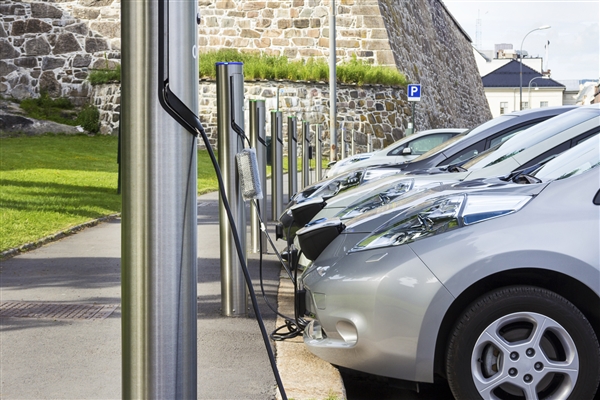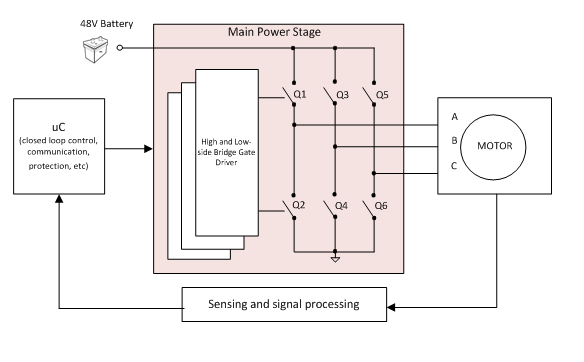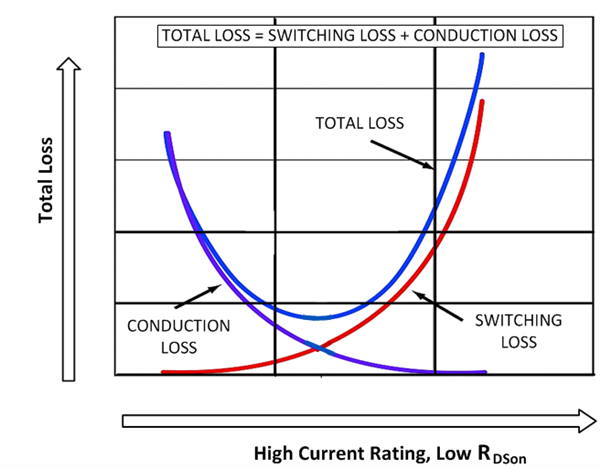SSZTCI5 july 2015 CSD19536KTT , UCC27201A , UCC27201A-Q1

In our previous blog on 48V automotive systems, Nagarajan Sridhar mentioned that tougher emission standards are driving new vehicle architectures. One way that automakers are meeting the CO2 emission goals is with mild hybrid configurations. Here, a 48V lithium-ion battery assists the combustion engine to propel the car; stores recuperated energy; and powers ancillary loads such as pumps, fans, heaters and compressors. These ancillary loads, which may have been previously driven by belts or hydraulics, are now electrified (e-loads). But how do you power e-loads off of a 48V battery? In this blog, I’ll discuss the main considerations in powering a brushless DC motor (BLDC) off of a 48V battery supply.
BLDCs are highly efficient motors and a good fit for battery e-load applications. They require a six-transistor inverter for the power stage (see Figure 1). The power bus voltage (in this case the 48V battery) is sequentially applied via pulse width modulation (PWM) in the range of 10-50kHz to the motor windings in order to create rotation. The main microcontroller controls commutation, which calculates the rotor position based on hall sensors or back electromotive force (EMF) from the motor and generates the PWM signals for the desired motor speed and torque response. Typically, a three-phase pre-driver or three half-bridge pre-drivers will drive the power transistors. The power stage, comprising the pre-drivers and transistors, plays a critical role in overall system efficiency and performance.
 Figure 1 Power inverter
Figure 1 Power inverterWhen designing the power stage, there are a number of key considerations, including DC bus voltage, power-transistor selection and gate-driver selection.
Bus Voltage
Let’s take a look at the power bus voltage. It’s a 48V battery, but of course this is the nominal voltage. The battery voltage varies across the usable state of charge, over temperature and under different charge/discharge loading conditions. The LV148 specification says that the range is between 24V and 52V, so you’ll need pre-drivers and power transistors that can handle the voltage at the switching-power nodes, plus some margin for potential spiking (inductive switching, load dumping, back EMF). In the 48V case, transistors and drivers that can handle at least 100V on the power nodes are a good choice.
Transistor Selection
In a mild hybrid application, realizing the most efficient use of battery power is one of the keys to meeting miles-per-gallon (mpg) and CO2 emission targets. An efficient inverter starts with transistor selection. First, consider the current ratings of the motor, both steady state and startup (startup current may be significantly higher than steady state). The transistor’s on-state resistance (RDSon) and corresponding current rating should exceed the peak motor requirements.
Beyond the power-handling capabilities, other key specifications for the MOSFET include gate charge (QG), parasitic capacitance (CISS, CRSS, COSS) and body-diode characteristics. All of these have an impact on power inverter efficiency. High-current MOSFETs with low RDSon minimize conduction losses (I2R), but typically have greater switching losses due to higher gate charges and parasitics. Figure 2 shows the trade-off between conduction loss and switching loss versus RDSon in MOSFETs.
 Figure 2 Trade-off between Switching
Losses and Conduction Losses
Figure 2 Trade-off between Switching
Losses and Conduction LossesConsidering the relatively low switching frequency (<50kHz) in the application, conduction losses will be a big part of the dissipation, so a low RDSon MOSFET is of high importance.
Gate-driver Selection
Switching power applications requires matching the gate driver with the transistor to ensure that the driver can supply the peak currents and meet the application’s turn-on and turn-off times. The optimal on-off time depends on the desired switching frequency, acceptable electromagnetic interference (EMI) generation and trace length from driver to gate.
The required peak drive current to control the transistors is proportional to the gate charge and selected on-off time. Equation 1 shows the relationship between gate charge, desired on-off time and required drive current.

I recommend choosing a gate driver with a peak current capability of 1.5~2 *
In instances where you need to slow down transitions (to reduce EMI, for example), you can add a gate resistor; however, this will add some delay time and increase switching losses.
For this application, the UCC27201A-Q1 120V 3A half-bridge driver (automotive qualified) and CSD19536KTT 100V N-channel NexFET™ power MOSFET are a good match.
Look out for our next 48V blog focused on the design considerations in more detail, including key design trade-offs and power and layout considerations.
Additional Resources:
View all 48V systems blogs